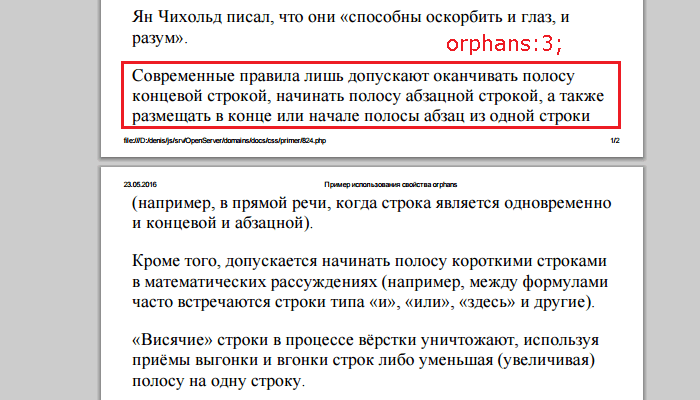
So a 5-line paragraph may not be broken across two pages at all, and 6-line paragraph may only be broken as 3 and 3 lines.

The example in the question thus means that a page break may not appear inside a p, h2, or h3 element, unless at least 3 lines of it appear on each page. It’s difficult to find use cases even for these. So why would you set those properties? Normally only as orphans: 1 or widows: 1 or both, to specify that typographic orphans or widows need not be avoided. The initial value of both properties is 2, which thus means that the single line orphans and widows (i.e., orphans and widows in the typographic sense) are to be avoided. It is rather difficult to find use for such a setting. Instead, it says that less than 4 lines of a paragraph at the end of a page be considered an orphan and be avoided. orphans: 4 does not mean four orphans anywhere. The definitions of the CSS properties are somewhat unnatural, since e.g. These generalizations are not particularly useful there is generally nothing wrong with having two (or three or.) lines of a paragraph on a page other than the rest of the paragraph.

The CSS concepts are generalizations of the typographic concepts, replacing "the last line" by "the last few lines" and "the first line" by "the first few lines". They are regarded as avoidable, though opinions disagree on how serious the problems are. So both are single lines that have been isolated from the rest of the paragraph by a page break.
#CSS WIDOWS AND ORPHANS HOW TO#
If you’d like to learn more about how to proofread texts of various kinds, our Becoming A Proofreader course was made for you! Sign up for a free trial today to find out more.In typography, a "widow" is the last line of a paragraph that appears at the start of a new page, and an "orphan" is the first line of a paragraph that appears at the end of a page. If they want you to then tweak the text to remove widows and/or orphans, you can do so. And many word processors even come with in-built features to prevent widows and orphans occurring.īut, if you know your client will be skipping the typesetting process and printing from the draft, you can note any issues with the layout you spot in the document. When copy editing a document in a word processor, meanwhile, widows, orphans, and runts aren’t usually an issue since the text isn’t set in place. However, you will not need to change them directly. You may even want to leave a comment with a suggestion for fixing it (e.g., cutting a word or two from a preceding line).

When proofreading a typeset text, such as the page proofs for a book, you’ll want to point out widows, orphans, and runts for your client. Thus, some designers and publishers prefer to avoid them.ĭue to the variation in terminology, moreover, it is always worth checking exactly what your client means if they mention widows, orphans, or runts in the brief for a proofreading job. Runts like these aren’t necessarily problems, but they can look untidy and leave a lot of extra white space on a page. What constitutes a runt also varies, though it can include anything less than half the width of a paragraph. These lonely words and phrases are also known as runts in some cases. A single word on a new line at the end of a paragraph.


 0 kommentar(er)
0 kommentar(er)
